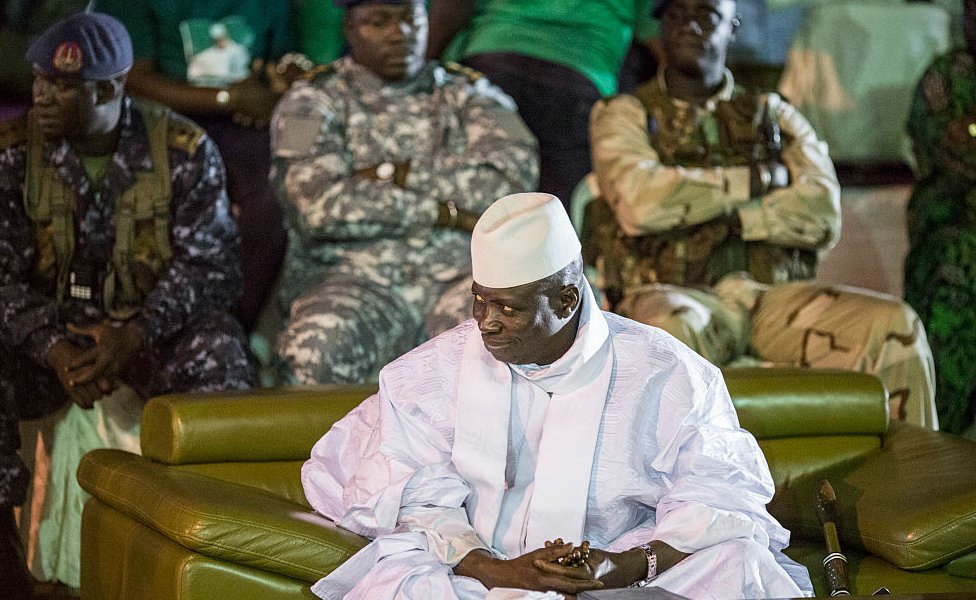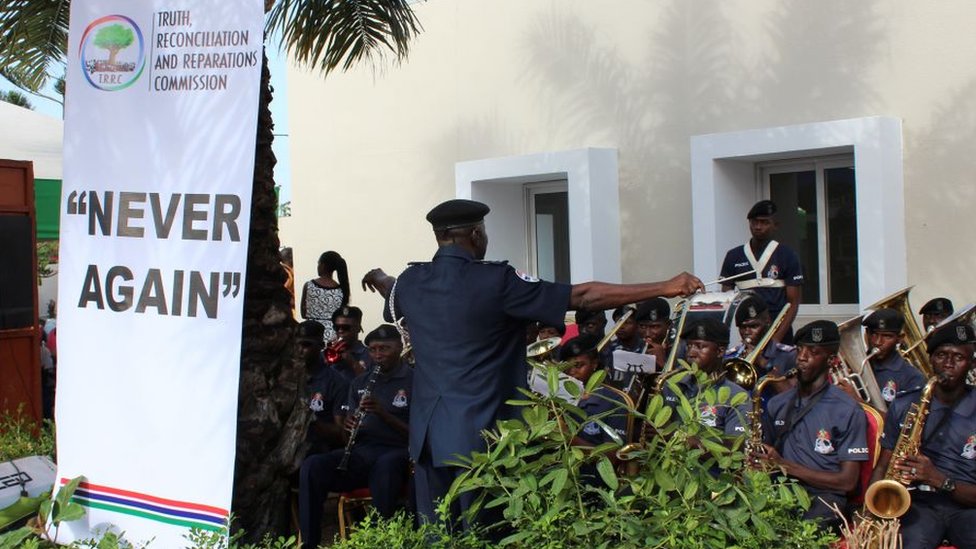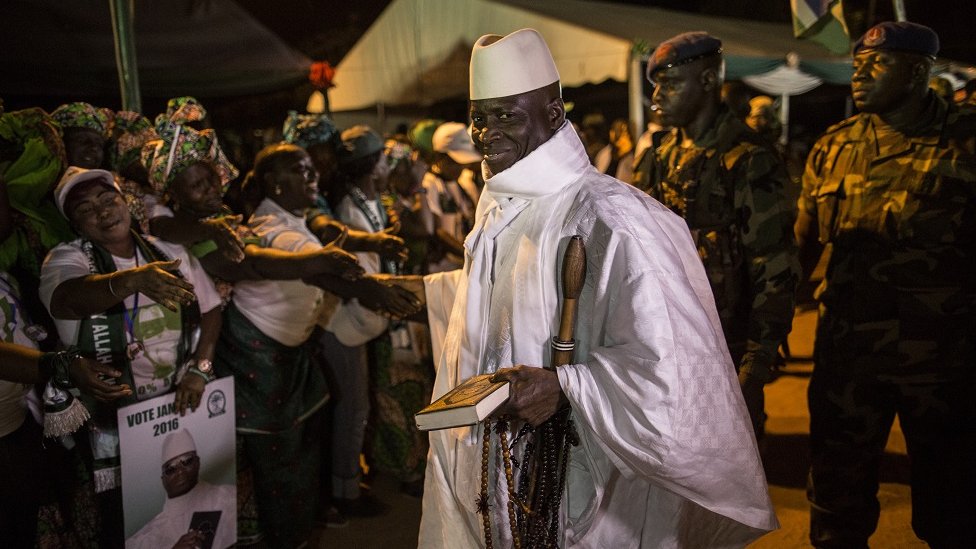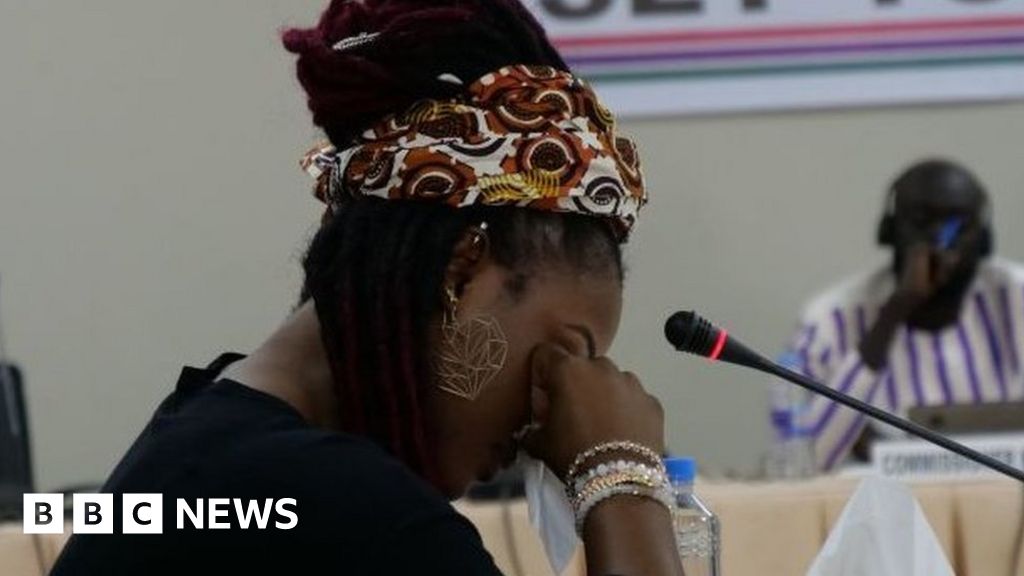image copyrightAFP
In our series of letters from African journalists, Sierra Leonean-Gambian writer Ade Daramy reflects on the impact that testimony at Gambia’s truth commission is having.
Gambians are being forced to re-evaluate their self-image as a relaxed, peace-loving people, who live on what is marketed to tourists as the “Smiling Coast”.
Revelation by revelation they are learning the shocking truth about what really happened during the 22-year rule of President Yahya Jammeh, which ended with him fleeing the country in 2017.
The proceedings of the Truth, Reconciliation and Reparations Commission (TRRC) have just passed the two-year mark and the live daily broadcasts have gripped the nation.
Viewers have heard stories of extreme violence and torture, arbitrary arrests and murder, and the impact of the president’s fake health cures.


Some things were always suspected, and there was no doubt that people feared President Jammeh, but the extent of the crimes has come as a surprise.
Here are five things that we have learnt so far:
1) The president’s ‘five-star hotels’ were not comfortable
Mr Jammeh was fond of joking that if anyone crossed him they would end up in one of his “five-star hotels” – his nickname for prisons.
Witnesses, both former inmates and guards, have told the TRRC that if an alleged crime related to the president, the torture of prisoners was guaranteed.
One former head of the National Intelligence Agency (NIA) admitted to the commission that following Mr Jammeh’s fall he tried to cover up the violence by having builders renovate a prison to get rid of the torture chamber and most of the equipment.


Many former prisoners have told the TRRC how they were jailed on the flimsiest of evidence.
One man admitted that he was a “witness for hire”, giving evidence in several high-profile cases (including alleged coup plots that led to people being executed) when he had no knowledge of the events. In all, he said he gave 32 paid-for statements against 12 people.
2) Informants were everywhere
Several witnesses have given evidence about how they were detained after someone passed their name on.
Omar Jatta was a victim of the NIA’s “special treatment”. He told the commission that he was arrested in 1995, taken to the NIA, undressed and electrocuted.
He was detained because he had been seen speaking to a veteran opposition politician at a naming ceremony.
I became aware of the fear of informants after attending a dinner-dance event in 1998. A comedian did a perfect impression of President Jammeh, but I was the only audience member out of 300 who was in stitches.
Everyone else just stared at the floor. Later, someone explained: “You never know who’s watching.”
3) Jammeh’s paranoia led to murder
A group of soldiers confessed to the capture and killing of over 50 African migrants, including 44 Ghanaians who, in July 2005, made the mistake of trying to travel through the country on their way to Europe.
They were arrested by security forces when their boat docked and with no evidence and no trial they were accused of being mercenaries hired for a possible coup attempt.


Over the following 10 days, almost all of those detained were killed in The Gambia or taken across the border into Senegal and shot and their bodies dumped in wells.
One soldier recounted how, just before he was shot, one of the migrants asked if he could reach into his pocket and retrieve something. It turned out to be a $100 bill which he handed to the soldier saying: “I obviously won’t be able to spend this, you can have it.”
The soldier admitted that he took it and spent.
4) Jammeh’s ‘HIV patients’ stripped naked
In one of his most outlandish claims, President Jammeh said in 2007 that he had a cure for HIV, asthma and diabetes.
He then took patients off conventional antiretroviral treatments and enrolled them in his Presidential Alternative Treatment Programme.
One witness, who was HIV-positive, said he had to strip naked. He then had a lotion rubbed on to his body and was given something to drink.
The patients who did not die are still HIV-positive and now undergoing conventional treatment.
5) The presidential convoy was deadly
When the president was on the road all traffic had to give way. So far, so normal but there were serious consequences for those who failed to move.
The TRRC has heard from several witnesses who were left disabled after not getting out of the way of the presidential convoy fast enough. Others died.
Sometimes, soldiers would break away from the stream of vehicles to beat up drivers or pedestrians who did not move in time.
Ade Daramy
While the truth about some of what happened now may be known, it is still not clear what room there is for reconciliation”


Mr Jammeh’s former family waiter was one of many to comment on his habit of throwing biscuits to crowds as the convoy swept past.
People scrambling to pick up the snacks would then get run over by other speeding cars in the entourage. The witness estimated that 20 were killed in this way between 2001 and 2008.



The stories that have come out from witnesses as well as perpetrators have led Gambians to reflect on what they knew of the country and themselves.
Before the TRRC it was common to hear people say that foreigners must have been behind any alleged atrocities. But not one self-confessed killer or torturer has proved to be from outside the country.
While the truth about some of what happened may now be known, it is still not clear what room there is for reconciliation.
The commission has at least another six months to run and only after its report is published will there be a final reckoning with The Gambia’s violent and troubled past.


![]()
More Letters from Africa:



Follow us on Twitter @BBCAfrica, on Facebook at BBC Africa or on Instagram at bbcafrica



